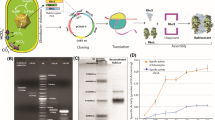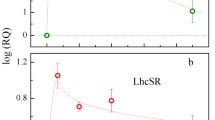Abstract
cDNA and the corresponding genomic DNA region encoding Rubisco activase were isolated from the unicellular green alga Chlorococcum littorale. The deduced amino acid sequence encoded by the cDNA was 403 amino acids long and exhibited important homology with those of other known Rubisco activases. Its N-terminal sequence was similar to the chloroplastic transit peptides in Chlamydomonas reinhardtii. The mature protein had a predicted molecular mass of 42 kDa. Five introns were located inside the genomic gene encoding Rubisco activase (rca). Genomic Southern blots indicated that two copies of the rca gene were present in the genome of C. littorale. The level of rca messenger RNA increased when cells of C. littorale were subjected to high-CO2 stress (i.e. grown under at least 20% CO2). Hsp70 heat-shock protein was also induced under high-CO2 conditions and, as expected, was also induced at 35 °C. The rca gene, in contrast, was not induced at 35 °C, indicating that this gene was induced in response to the high CO2 concentration and not to general stress. A search of the promoter-binding proteins by a gel retardation assay showed that, under the high-CO2 conditions, a protein(s) which was probably an activator of the rca transcription was synthesized.
Similar content being viewed by others
References
Aizawa, K. and Miyachi, S. 1986. Carbonic anhydrase and CO 2 concentrating mechanisms in microalgae and cyanobacteria. FEMS Microbiol. Rev. 39: 215-233.
Bucher, P. 1990. Weight matrix descriptions of four eukaryotic RNA polymerase II promoter elements derived from 502 unrelated promoter sequences. J. Mol. Biol 212: 563-578
Chomczynski, P. and Sacchi, N. 1987. Single step method of RNA isolation by acid guanidinium thiocyanate-phenol-chloroform extraction. Anal. Biochem. 162: 156-159
Franzèn, L.G., Rochaix, J.D. and von Heijne, G. 1990. Chloro-plast transit peptides from the green alga Chlamydomonas rein-hardtii share features with both mitochondrial and higher plant chloroplast pre-sequences. FEBS Lett. 260: 165-168.
Gavel, Y. and von Heijne, G. 1990. A conserved cleavage-site motif in chloroplast transit peptides. FEBS Lett. 261: 455-458.
Kindle, K.L., Schnell, R.A., Fernández, E. and Lefebvre, P.A. 1989. Stable nuclear transformation of Chlamydomonas using the Chlamydomonas gene for nitrate reductase. J. Cell. Biol. 109: 2589-2601.
Kodama, M., Ikemoto, H. and Miyachi, S. 1993. A new species of highly CO 2-tolerant fast-growing marine microalga suitable for high-density culture. J. Mar. Biotechnol. 1: 21-25
Miziorko, H.M. and Lorimer, G.H. 1983. Ribulose-1,5-bisphosphate carboxylase/oxygenase. Annu. Rev. Biochem. 52: 507-535.
Ochman, H., Ajioka, J.W., Garza, D. and Hartl, D.L. 1989. Inverse polymerase chain reaction. In: H.A. Erlich (Ed.), PCR Technology, Stockton Press, USA, pp. 105-111.
Pesheva, I., Kodama, M., Dionisio-Sese, M.L. and Miyachi, S. 1994. Changes in photosynthetic characteristics induced by transferring air-grown cells of Chlorococcum littorale to high-CO 2 conditions. Plant Cell Physiol. 35: 379-387.
Portis, A.R. Jr. 1990. Rubisco activase. Biochim. Biophys. Acta 1015: 15-28.
Portis, A.R. Jr. 1992. Regulation of ribulose 1,5-bisphosphate car-boxylase/ oxygenase activity. Annu. Rev. Plant Physiol. Plant Mol. Biol. 43: 415-437.
Portis, A.R. Jr., Salvucci, M.E. and Ogren, W.L. 1986. Activation of ribulose bisphosphate carboxylase/oxygenase at physiologi-cal CO 2 and ribulose bisphosphate concentrations by Rubisco activase. Plant Physiol. 82: 967-971.
Rawat, M. and Moroney, J.V. 1995. The regulation of carbonic anhydrase and ribulose-1,5-bisphosphate carboxylase/oxygenase activase by light and CO 2 in Chlamydomonas reinhardtii. Plant Physiol. 109: 937-944.
Roesler, K.R. and Ogren, W.L. 1990. Primary structure of Chlamydomonas reinhardtii ribulose 1,5-bisphosphate carboxy-lase/ oxygenase activase and evidence for a single polypeptide. Plant Physiol. 94: 1837-1841.
Rundle, S.J. and Zielinski, R.E. 1991. Organization and expression of two tandemly oriented genes encoding ribulose bisphosphate carboxylase/oxygenase activase in barley. J. Biol. Chem. 266: 4677-4685
Sage, R.F., Sharkey, T.D. and Seeman, J.R. 1989. Acclimatation of photosynthesis to elevated CO 2 in five C 3 species. Plant Physiol. 89: 590-596.
Sãnchez de Jimenez, E., Medrano, L. and Martinez-Barajas, E. 1995. Rubisco activase, a possible member of the molecular chaperone family. Biochemistry 34: 2826-2831.
Sobczyk, A., Schyns, G., Tandeau de Marsac, N. and Houmard, J. 1993. Transduction of the light signal during complementary chromatic adaptation in the cyanobacterium Calothrix sp. PCC 7601: DNA-binding proteins and modulation by phosphorylation. EMBO J. 13: 997-1004.
Streusand, V.J. and Portis A.R. Jr. 1987. Rubisco activase mediates ATP-dependent activation of ribulose bisphosphate carboxylase. Plant Physiol. 85: 152-154.
Triezenberg, S.J. 1992. Primer extension. In: Ausubel FM, Brent R, Kingston, RE Seidman JG, Smith JA, Struhl K (Eds.), Currents Protocols in Molecular Biology, Current Protocols, Canada, pp. 4.8.1-4.8.5.
van de Loo, F.J. and Salvucci, M.E. 1996. Activation of ribulose 1,5-bisphosphate carboxylase/oxygenase (Rubisco) involves Rubisco activase Trp16. Biochemistry 35: 8143-8148.
von Heijne, G., 1988. Transcending the impenetrable: how proteins come to terms with membranes. Biochim. Biophys. Acta 947: 307-333.
Webber, A.N., Nie, G.Y. and Long, S.P. 1994. Acclimatation of photosynthetic proteins to rising atmospheric CO 2. Photosyn. Res. 39: 413-425.
Winder, T.L., Anderson, J.C. and Spalding, M.H. 1992. Translational regulation of the large and small subunits of ribulose bisphosphate carboxylase/oxygenase during induction of the CO 2-concentrating mechanism in Chlamydomonas reinhardtii. Plant Physiol. 98: 1409-1414.
Yokota, A. and Canvin, D.T. 1986. Changes of ribulose bisphosphate carboxylase/oxygenase content, ribulose bisphosphate concentration and photosynthetic activity during adaptation of high-CO 2 grown cells to low CO 2 conditions in Chlorella pyrenoidosa. Plant Physiol. 80: 341-345.
Zielinski, R.E., Werneke, J.M. and Jenkins, M.E. 1988. Coordinate expression of Rubisco activase and Rubisco during barley leaf cell development. Plant Physiol. 90: 516-521.
Author information
Authors and Affiliations
Rights and permissions
About this article
Cite this article
Beuf, L., Kurano, N. & Miyachi, S. Rubisco activase transcript (rca) abundance increases when the marine unicellular green alga Chlorococcum littorale is grown under high-CO2 stress. Plant Mol Biol 41, 627–635 (1999). https://doi.org/10.1023/A:1006371905597
Issue Date:
DOI: https://doi.org/10.1023/A:1006371905597




